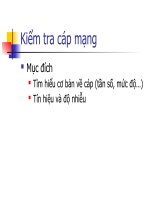bài giảng mạng máy tính căn bản chương 6 nguyên lý cơ bản của etherne
Bạn đang xem bản rút gọn của tài liệu. Xem và tải ngay bản đầy đủ của tài liệu tại đây (1.45 MB, 134 trang )
Phan Vĩnh Thuần Computer Network 1
Chương 6
NGUYÊN LÝ CƠ BẢN CỦA ETHERNET
(ETHERNET FUNDAMENTALS)
Phan Vĩnh Thuần Computer Network 2
Overview
•
Ethernet is now the dominant LAN
technology in the world. Ethernet is
not one technology but a family of
LAN technologies and may be best
understood by using the OSI reference
model.
Phan Vĩnh Thuần Computer Network 3
•
All LANs must deal with the basic
issue of how individual stations
(nodes) are named, and Ethernet is
no exception. Ethernet specifications
support different media, bandwidths,
and other Layer 1 and 2 variations.
However, the basic frame format and
addressing scheme is the same for
all varieties of Ethernet.
Phan Vĩnh Thuần Computer Network 4
•
For multiple stations to access
physical media and other networking
devices, various media access control
strategies have been invented.
Understanding how network devices
gain access to the network media is
essential for understanding and
troubleshooting the operation of the
entire network.
Phan Vĩnh Thuần Computer Network 5
•
Students completing this module should
be able to:
–
Describe the basics of Ethernet
technology.
–
Explain naming rules of Ethernet
technology.
–
Define how Ethernet and the OSI model
interact.
–
Describe the Ethernet framing process
and frame structure.
–
List Ethernet frame field names and
purposes.
Phan Vĩnh Thuần Computer Network 6
–
Identify the characteristics of
CSMA/CD.
–
Describe the key aspects of Ethernet
timing, interframe spacing and
backoff time after a collision.
–
Define Ethernet errors and collisions.
–
Explain the concept of auto-
negotiation in relation to speed and
duplex.
Phan Vĩnh Thuần Computer Network 7
6.1. Ethernet Fundamentals
6.1.1. Introduction to Ethernet
•
Most of the traffic on the Internet
originates and ends with Ethernet
connections. From its beginning in the
1970s, Ethernet has evolved to meet the
increasing demand for high speed LANs.
When a new media was produced, such
as optical fiber, Ethernet adapted to take
advantage of the superior bandwidth and
low error rate that fiber offers. Now, the
same protocol that transported data at 3
Mbps in 1973 is carrying data at 10 Gbps.
Phan Vĩnh Thuần Computer Network 8
•
The success of Ethernet is due to the
following factors:
–
Simplicity and ease of maintenance
–
Ability to incorporate new technologies
–
Reliability
–
Low cost of installation and upgrade
•
With the introduction of Gigabit Ethernet,
what started as a LAN technology now
extends out to distances that make
Ethernet a metropolitan-area network
(MAN) and wide-area network (WAN)
standard
Phan Vĩnh Thuần Computer Network 9
•
The original idea for Ethernet grew out
of the problem of allowing two or more
hosts to use the same medium and
prevent the signals from interfering
with each other. This problem of
multiple user access to a shared
medium was studied in the early 1970s
at the University of Hawaii.
Phan Vĩnh Thuần Computer Network 10
•
A system called Alohanet was
developed to allow various stations
on the Hawaiian Islands structured
access to the shared radio frequency
band in the atmosphere. This work
later formed the basis for the
Ethernet access method known as
CSMA/CD (Carrier Sense Multiple
Access/Collision Detection)
Phan Vĩnh Thuần Computer Network 11
•
The first LAN in the world was the
original version of Ethernet. Robert
Metcalfe and his coworkers at Xerox
designed it more than thirty years ago.
The first Ethernet standard was
published in 1980 by a consortium of
Digital Equipment Company, Intel, and
Xerox (DIX). Metcalfe wanted Ethernet
to be a shared standard from which
everyone could benefit, so it was
released as an open standard.
Phan Vĩnh Thuần Computer Network 12
•
The first products developed using the
Ethernet standard were sold during the
early 1980s. Ethernet transmitted at up to
10 Mbps over thick coaxial cable up to a
distance of two kilometers. This type of
coaxial cable was referred to as thicknet
•
In 1985, the Institute of Electrical and
Electronics Engineers (IEEE) standards
committee for Local and Metropolitan
Networks published standards for LANs.
Phan Vĩnh Thuần Computer Network 13
•
These standards start with the number
802. The standard for Ethernet is 802.3.
The IEEE wanted to make sure that its
standards were compatible with the
International Standards Organization
(ISO)/OSI model. To do this, the IEEE
802.3 standard had to address the
needs of Layer 1 and the lower portion
of Layer 2 of the OSI model. As a result,
some small modifications to the original
Ethernet standard were made in 802.3.
Phan Vĩnh Thuần Computer Network 14
•
The differences between the two
standards were so minor that any
Ethernet network interface card (NIC)
can transmit and receive both Ethernet
and 802.3 frames. Essentially, Ethernet
and IEEE 802.3 are the same
standards.
Phan Vĩnh Thuần Computer Network 15
•
The 10-Mbps bandwidth of Ethernet was
more than enough for the slow personal
computers (PCs) of the 1980s. By the
early 1990s PCs became much faster, file
sizes increased, and data flow
bottlenecks were occurring. Most were
caused by the low availability of
bandwidth. In 1995, IEEE announced a
standard for a 100-Mbps Ethernet. This
was followed by standards for gigabit
per second (Gbps, 1 billion bits per
second) Ethernet in 1998 and 1999.
Phan Vĩnh Thuần Computer Network 16
•
All the standards are essentially
compatible with the original Ethernet
standard. An Ethernet frame could leave
an older coax 10-Mbps NIC in a PC, be
placed onto a 10-Gbps Ethernet fiber link,
and end up at a 100-Mbps NIC. As long as
the packet stays on Ethernet networks it
is not changed. For this reason Ethernet
is considered very scalable. The
bandwidth of the network could be
increased many times without changing
the underlying Ethernet technology.
Phan Vĩnh Thuần Computer Network 17
•
The original Ethernet standard has
been amended a number of times in
order to manage new transmission
media and higher transmission rates.
These amendments provide standards
for the emerging technologies and
maintain compatibility between
Ethernet variations.
Phan Vĩnh Thuần Computer Network 18
6.1.2. IEEE Ethernet naming rules
•
Ethernet is not one networking
technology, but a family of networking
technologies that includes Legacy,
Fast Ethernet, and Gigabit Ethernet.
Ethernet speeds can be 10, 100, 1000,
or 10,000 Mbps. The basic frame
format and the IEEE sublayers of OSI
Layers 1 and 2 remain consistent
across all forms of Ethernet.
Phan Vĩnh Thuần Computer Network 19
•
When Ethernet needs to be
expanded to add a new medium or
capability, the IEEE issues a new
supplement to the 802.3 standard.
The new supplements are given a
one or two letter designation such
as 802.3u. An abbreviated
description (called an identifier) is
also assigned to the supplement.
Phan Vĩnh Thuần Computer Network 20
•
The abbreviated description consists
of:
–
A number indicating the number of
Mbps transmitted.
–
The word base, indicating that
baseband signaling is used.
–
One or more letters of the alphabet
indicating the type of medium used
(F= fiber optical cable, T = copper
unshielded twisted pair).
Phan Vĩnh Thuần Computer Network 21
•
Ethernet relies on baseband signaling,
which uses the entire bandwidth of the
transmission medium. The data signal
is transmitted directly over the
transmission medium. In broadband
signaling, not used by Ethernet, the
data signal is never placed directly on
the transmission medium. An analog
signal (carrier signal) is modulated by
the data signal and the modulated
carrier signal is transmitted. Radio
broadcasts and cable TV use
broadband signaling.
Phan Vĩnh Thuần Computer Network 22
Phan Vĩnh Thuần Computer Network 23
6.1.3. Ethernet and the OSI model
•
Ethernet operates in two areas of the
OSI model, the lower half of the data
link layer, known as the MAC sublayer
and the physical layer.
Phan Vĩnh Thuần Computer Network 24
Phan Vĩnh Thuần Computer Network 25
•
To move data between one Ethernet
station and another, the data often
passes through a repeater. All other
stations in the same collision domain
see traffic that passes through a
repeater. A collision domain is then a
shared resource. Problems originating
in one part of the collision domain will
usually impact the entire collision
domain.









